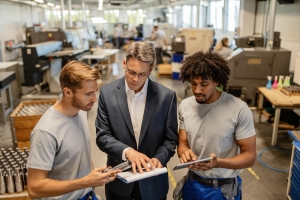Semiconductor materials are important components of chipmaking. These comprise silicon wafers and special substrates, process gases and chemicals, photoresists, CMP slurries, high-purity water and filtration systems, packaging substrates and glasses, and the consumables used in fabrication and test. The announcement of a new fab or packaging plant typically leads to highlights either the equipment vendor or the fab owner raising demand; however, it is the material that causes a fab to keep running steadily and even leads to the creation of adjacent clusters of supplier investments.
The materials have become strategically and economically important due to two recent trends:
(1) the compressing time and capital intensity at the leading edge, i.e., every new node requires new materials and tighter purity specs.
(2) the rapid scale-up of capacity to meet the needs of AI and data centers, which increases the wafer starts substantially and thus the recurring materials consumption.
In short, the United States government can help with the capacity; however, the demand from new compute workloads is the multiplier that turns one fab into a whole ecosystem of upstream suppliers.
Policy levers: how the U.S. government turned incentives into supplier demand
The fact sheet by the National Institute of Standards and Technology (NIST) titled “CHIPS for America: Federal Programs Supporting the U.S. Semiconductor Supply Chain and Workforce' of March 2024 mentions that policy and funding, including tax credits and grants. The policy law directs diverse incentives and programs for research and development, domestic manufacturing, and workforce development, which lead to growth in demand for locally based semiconductor material suppliers.
CHIPS for America: Federal Programs Supporting the U.S. Semiconductor Supply Chain and Workforce
The CHIPS and Science Act, through Commerce, has given the U.S. Department of Commerce about $52.7 billion for the period of five years to support areas like semiconductor manufacturing, R&D, and workforce development.
The U.S. Department of Commerce set up two offices to carry out the implementation of the Act:
- CHIPS Program Office that will manage the distribution of $39 billion in the form of tax breaks or financial returns for investment in the buildings and machinery
- CHIPS Research & Development (R&D) Office, which will provide $11 billion to create a domestic semiconductor R&D ecosystem
Incentive Opportunities under the CHIPS Program Office
The two main categories of projects are the ones on which the CHIPS Program Office is inviting funding opportunities for are:
- Construction, expansion, or modernization of commercial facilities for leading-edge, current-generation, or mature-node semiconductors
- Construction, expansion, or modernization of facilities for semiconductor materials and manufacturing equipment
R&D Programs & Allocations
The CHIPS R&D Office is offering an integrated four-program approach to bridging the domestic ecosystem gap. The estimated allocations of funds (at least) in the respective order are as follows:
- NSTC (National Semiconductor Technology Center): $5 billion
- NAPMP (National Advanced Packaging Manufacturing Program): $3 billion
- CHIPS Metrology Program: $519 million
- CHIPS Manufacturing USA Institute: $200 million
The focus of these programs is to make advances in the areas of innovation, commercialization, and support for the U.S. semiconductor industry to be competitive.
Additional CHIPS-Related Federal Programs
In addition to the primary CHIPS funding, the fact sheet presents a number of other programs by different agencies that are meant to enhance the semiconductor supply chain and the supporting infrastructure that is already in place in the country.
Department of Defense: CHIPS for America Defense Funding.
- Department of Defense will manage a network for hardware prototyping, lab-to-fab transitions, and skilled labor training called Microelectronics Commons at a cost to the government of $2 billion.
- In September 2023, the Department of Defense gave almost $240 million to eight different "Innovation Hubs" through a regional distribution covering 35 states, Washington, D.C., and Puerto Rico.
- Research areas are electromagnetic warfare, secure computing, AI hardware, 5G/6G, quantum, and others.
- The eight innovation hubs are as follows:
- Northeast Microelectronics Coalition (Massachusetts) – $19.7 million
- Silicon Crossroads Microelectronics Commons (Indiana) – $32.9 million
- California Defense Ready Electronics & Microdevices Superhub – $26.9 million
- Commercial Leap Ahead for Wide Bandgap Semiconductors (North Carolina) – $39.4 million
- Southwest Advanced Prototyping Hub (Arizona) – $39.8 million
- Midwest Microelectronics Consortium (Ohio) – $24.3 million
- Northeast Regional Defense Technology Hub (New York) – $40 million
- California-Pacific Northwest AI Hardware Hub (California) – $15.3 million
Department of State: International Technology Security & Innovation Fund
- The State Department, together with USAID, Ex-Im, and the U.S. International Development Finance Corporation, provided $500 million to promote international semiconductor and ICT supply chain activities, especially by fostering secure and trusted technologies.
National Science Foundation: Workforce & Education Fund
- The NSF has allocated $200 million over a period of five years to aid in the formation of a domestic semiconductor workforce.
Department of Commerce (NTIA): Public Wireless Supply Chain Innovation Fund
- The National Telecommunications and Information Administration (NTIA) will allocate $1.5 billion to support U.S. competitiveness in telecom technologies. Although this area is not directly related to semiconductors, this incentive aligns with the semiconductor sector.
CHIPS Funding Programs by Agency & Funds, in USD Million
Source: CHIPS for America Fact Sheet
Additional Federal Incentives for Manufacturers & Suppliers
The fact sheet not only presents the direct allocations of CHIPS, but also outlines the tax incentives and credits that are administered by the Treasury in order to promote investments and manufacturing in the semiconductor sector.
Department of the Treasury: 48D Advanced Manufacturing Investment Credit
- One of the key incentives that Treasury is putting into practice is the semiconductor manufacturing tax credit, which is an ITC based on the CHIPS investment, which will be available for all capital expenditure considered "qualified" on the semiconductor manufacturing facilities or equipment that are integral to such facilities.
- It has been anticipated that the credit will be as much as 25% of the qualified capital expenditures.
- The Elective Pay option enables companies to get the credit in a refundable manner, which implies that the semiconductor manufacturers and equipment makers will be able to get the total value of the credit.
- The credit typically pertains to the property for which the construction was started post-August 9, 2022, and is operational after December 31, 2022.
- Treasury declared the draft regulations for Section 48D in March 2023 and is taking into account the input from the public.
Department of the Treasury: 45X Advanced Manufacturing Production Tax Credit
- The 45X tax credit is dedicated to the support of the clean energy supply chain components, which are produced in the U.S., and that might encompass the components of semiconductors or photovoltaic wafers.
- The eligible products include:
- Solar, wind, and energy storage systems' finished equipment or component parts
- Equipment for electricity inverters
- Critical minerals purified to the required purity levels
- Photovoltaic wafers (semiconducting substrate)
Market forces: demand, technology, and the capital cycle
- AI and hyperscale computing together form a powerful demand multiplier.
High-performance accelerators and GPUs have been the main beneficiaries of the AI adoption that included large language models, generative AI, image, and multimodal inference. These devices are primarily produced at the advanced node and make use of the best existing packaging and substrates (HBM, 2.5D/3D stacking). Thus, there is a direct correlation between high per-chip materials and the application of more substrate layers, more precision bonding materials, special die-attach compounds, and advanced glass interposers in semiconductor power. To meet the demand from United States hyperscalers, foundries, and OSATs (outsourced semiconductor assembly and test providers) are increasing their production capabilities, which in turn multiplies the consumption of materials. Furthermore, industry outlooks suggest that AI and data center demand will be the major drivers of robust growth in the near term.
- The automotive and industrial sectors have also driven the demand for semiconductor material in the country.
Software and hardware for the car of the future scenario have already created the need for more semiconductors in the automotive sector. These automotive and industrial semiconductors are often produced at lower technology nodes, but still consume huge amounts of wafers and packaging materials (such as silicon carbide wafers and power substrates) regularly due to the large volume produced. With the increase in the number of electric vehicles (EVs) on the road, this will, in turn, bring about the need for more materials and thus support the investment in materials lines targeting mid-to-mature processes.
- Investment commitments and the foundry cycle
The market trend is reflected in the capital expenditure commitments of foundries and fab operators. When TSMC, Samsung, Intel, or leading OSATs declare that they are building new fabs or packaging campuses in the U.S., suppliers of gases, specialty chemicals, filtration, and substrates can count on receiving a predictable multi-year order book. Consequently, the foundry capital expenditure cycle is a primary factor, as the more semiconductors there are in the U.S., the greater the recurring demand for consumable semiconductor materials.
Conclusion
Presently, the U.S. semiconductor materials market is the result of both planned public policy and strong market demand. CHIPS and associated programs increased the cost and risk of placing fabs and packaging lines onshore, thereby sending promising demand signals to materials suppliers. Furthermore, it is the over-the-top growth in computing, such as AI, cloud, and the electrification of transport, that consumes materials at a faster rate and converts one-off grants into long-term purchase streams.
If the policymakers, industry, and investors work together excellently, the country will not only be able to accommodate more semiconductors but also develop a strong upstream and midstream materials industry that ensures the availability of supply chains, creates high-value jobs, and secures technical independence.





